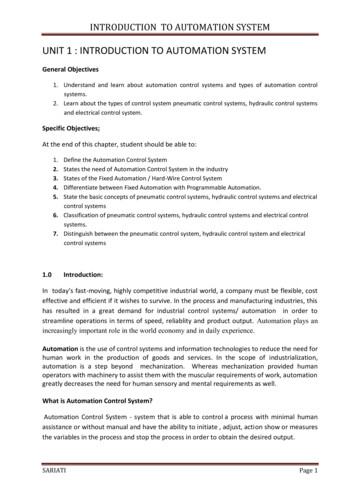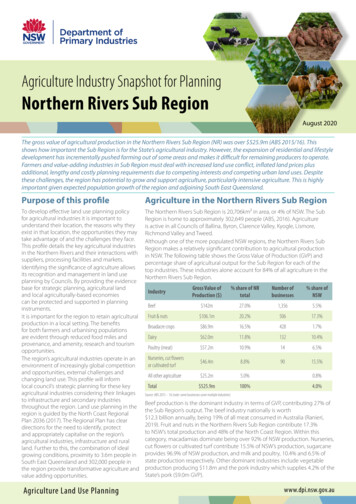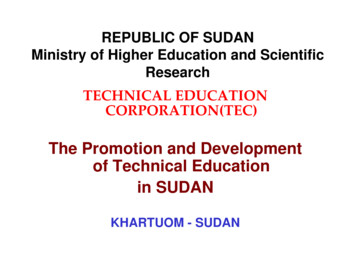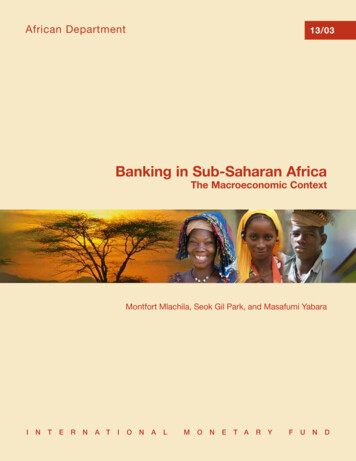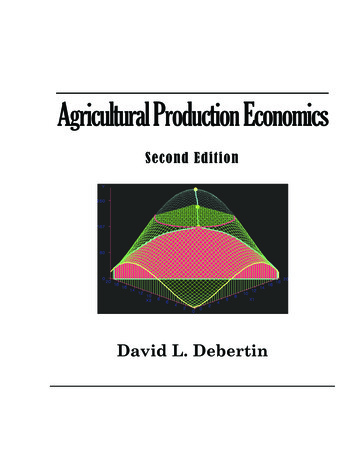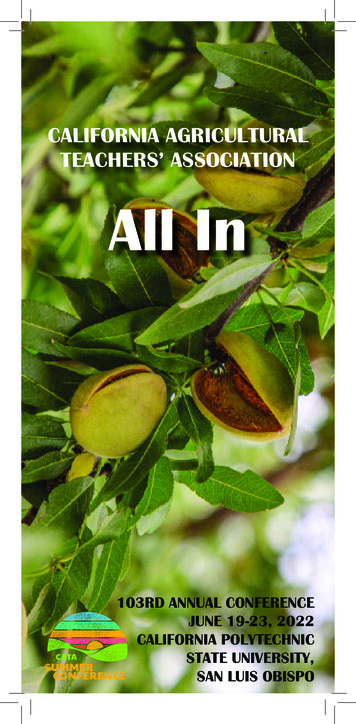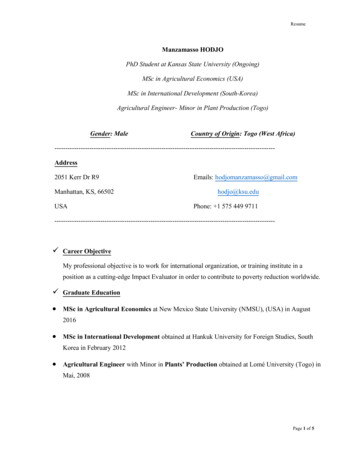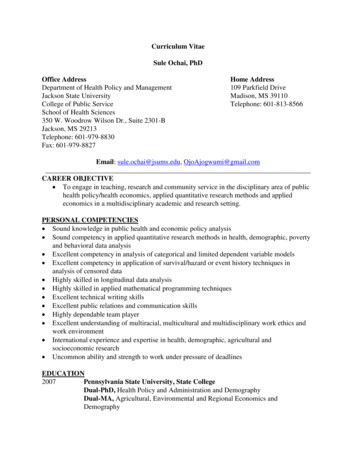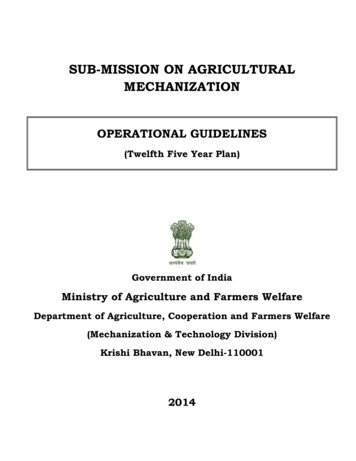
Transcription
SUB-MISSION ON AGRICULTURALMECHANIZATIONOPERATIONAL GUIDELINES(Twelfth Five Year Plan)Government of IndiaMinistry of Agriculture and Farmers WelfareDepartment of Agriculture, Cooperation and Farmers Welfare(Mechanization & Technology Division)Krishi Bhavan, New Delhi-1100012014
TABLE OF i PageContentsIntroductionMission ObjectivesMission strategyMission ComponentsPosition of ongoing schemesMission StructureNational levelExecutive CommitteeState LevelDistrict levelRole of Panchayti RajProcedure for Approvals and Fund Flow MechanismAAP SubmissionMonitoringImpact Assessment, Periodic Evaluation and ReportingExpected OutcomesInterventionsCentral Sector ComponentsImplementing AgenciesTrainingTestingDemonstrationEstablishment of Post Harvest TechnologyInterventions under Centrally Sponsored SchemesFinancial Assistance for Procurement of Agriculture Machinery& EquipmentFarm Machinery Banks for Custom HiringHi-tech, High Productive Equipment Hub for Custom HiringPromotion of Farm Mechanization in Selected VillagesAssistance for Mechanized OperationsPromotion of Farm Machinery & Equipments in North –EasternExposure visitsActivity MappingPage No.111223334677788888991012141515Activity Mapping for effective devolution of funds, functions andfunctionaries under Sub Mission on Agricultural MechanizationCost Norms and Pattern of Assistance under Sub Mission onAgricultural Mechanization (SMAM) During 12th PlanFormula to Calculate Farm Power AvailabilityList of Training Programmes conducted at Farm Machinery Training &Testing InstitutesList of institutions approved by Department of Agriculture &Cooperation, Ministry of Agriculture for Testing and CertifyingAgricultural Machineries and EquipmentsTesting ChargesFormat for Annual Action PlanForm of Utilization CertificateFormat for Quarterly /Annual Progress Report21151718191920202340414446475051
IPHETCMVRCSAMCSIRDAC& MNHMNIAEii P a g eAnnual Action PlanAgriculture & CooperationAdditional CommissionerAssistant Director GeneralAdditional District MagistrateAll India Coordinated Research ProjectAgricultural Technology Management AgencyBureau of Indian StandardsCentral Farm Machinery Training & Testing InstituteCustom Hiring CentersCentral Institute of Post Harvest Engineering & TechnologyCentral Motor Vehicle RulesCentral for Sustainable Agricultural MechanizationCouncil of Scientific and Industrial researchDepartment of Agriculture, Cooperation and Farmers WelfareDeputy CommissionerDeputy Director (Agriculture)Deputy Director GeneralDistrict Level Executive CommitteeExecutive CommitteeExecutive Engineer (Agriculture)Farm Machinery Training & Testing InstituteFarmer Producer OrganizationGovernment of IndiaHectareHorse PowerIndian Council of Agricultural ResearchInternational Crop Research Institute for Semi-Arid TropicsInformation Communication TechnologyInternational Rice Research InstituteJoint Director (Agriculture)Japan International Cooperation AgencyKrishi Vigyan KendraKilo-WattMechanization & TechnologyMission for Integrated Development of HorticultureMission Integration PlanningManagement Information SystemNational Bank for Agriculture & Rural DevelopmentNorth Eastern Region Farm Machinery Training & Testing InstituteNational Food Security MissionNational Horticulture MissionNational Institute of Agricultural Engineering
FACSHGSLECSMAMSRFMTTISTTSPUGUTiii P a g eNational Mission on Oil Seeds & Oil PalmsNorthern Region Farm Machinery Training & Testing InstituteNational Steering CommitteePost Harvest TechnologyPost Harvest Technology & ManagementPublic Private PartnershipPanchayati Raj InstitutionsPublic Sector UndertakingPower Take OffQuarterly Progress ReportResearch & DevelopmentRashtriya Krishi Vikas YojanaState Agricultural UniversityScheduled CasteSmall Farmers Agri-Business ConsortiumSelf Help GroupsState Level Executive CommitteeSub mission on Agricultural MechanizationSouthern Region Farm Machinery Training & Testing InstituteSchedule TribesTribal Sub PlanUser GroupsUnion Territory
1.0 Introduction(i) Among the states, farm power availability in Punjab, Haryana, WesternUttar Pradesh and western part of Rajasthan is higher than the nationalaverage of 1.73kW/ha. In rest of the country, especially in Eastern andNorth-East Regions, it is significantly lower which necessities promotionof farm mechanization as a special Mission.(ii) Sub Mission on Agricultural Mechanization (SMAM) will be implementedin accordance with guidelines described hereunder.(iii) The scheme will be implemented in all the states, to promote the usage offarm mechanization and increase the ratio of farm power to cultivableunit area up to 2 kW/ha.(iv) SMAM will have central sector schemes under component No.1& 2.Centrally Sponsored schemes are covered under component No.3 to 8inwhich Government of India contributes 75% and states contribute 25%.2.0Mission ObjectivesThe Mission objectives are as follows:(i) Increasing the reach of farm mechanization to small and marginalfarmers and to the regions where availability of farm power is low;(ii) Promoting ‘Custom Hiring Centres’ to offset the adverse economies ofscale arising due to small landholding and high cost of individualownership;(iii) Creating hubs for hi-tech& high value farm equipments;(iv) Creating awareness among stakeholders through demonstration andcapacity building activities;(v) Ensuring performance testing and certification at designated testingcenters located all over the country.3.0 Mission StrategyTo achieve the above objectives, the Mission will adopt the followingstrategies:(i) Conduct performance testing for various farm machineries andequipments at the four Farm Machinery Training and Testing Institutes(FMTTI), designated State Agricultural Universities (SAUs) and ICARinstitutions;(ii) Promote farm mechanization among stakeholders by way of on-field andoff-field training and demonstrations.(iii)Provide financial assistance to farmers for procurement of farmmachinery and implements(iv) Establish custom hiring centres of location and crop specific farmmachinery and implements(v) Provide financial assistance to small and marginal farmers for hiringmachinery and implements in low mechanized regions.1 Page
4.0Mission Components4.1 Promotion and Strengthening of Agricultural Mechanization throughTraining, Testing and Demonstration: aims to ensure performance testingof agricultural machinery and equipment, capacity building of farmers and endusers and promoting farm mechanization through demonstrations.4.2 Demonstration, Training and distribution of Post Harvest Technologyand Management (PHTM): aims at popularizing the technology for primaryprocessing, value addition, low cost scientific storage/transport and the cropby-product management through demonstrations, capacity building of farmersand end users. Provides financial assistance for establishing PHT units.4.3 Financial Assistance for Procurement of Agriculture Machinery andEquipment: Promotes ownership of various agricultural machinery &equipments as per norms of assistance.4.4 Establish Farm Machinery Banks for Custom Hiring: Provides suitablefinancial assistance to establish Farm Machinery Banks for Custom Hiring forappropriate locations and crops.4.5 Establish Hi-Tech, High Productive Equipment Hub for CustomHiring: Provides financial assistance to set up hi-tech machinery hubs for highvalue crops like sugarcane, cotton etc.4.6 Promotion of farm mechanisation in selected villages: Providesfinancial assistance to promote appropriate technologies and to set up FarmMachinery Banks in identified villages in low mechanised states.4.7 Financial Assistance for promotion of Mechanized operations/hectarecarried out through custom hiring Centres: Provides financial assistance onper hectare basis to the beneficiaries hiring machinery/equipments fromcustom hiring centres in low mechanized areas.4.8 Promotion of farm machinery and equipment in north easternregion: Extends financial assistance to beneficiaries in high-potential but lowmechanised states of north-east.5.0 POSITION OF ONGOING SCHEMESFarm Mechanization programmes are also being implemented through othermissions/schemes such as RKVY, MIDH, NMOOP & NFSM, which would becontinued to be implemented subject to these guidelines. The Central Sectorschemes ‘Promotion and Strengthening of Agricultural Mechanisation throughTraining, Testing and Demonstration’ and ‘Post Harvest Technology &Management’ are merged with this Sub-Mission.2 Page
6.0Mission Structure6.1 National LevelThe Mission will have a National Steering Committee (NSC) underChairmanship of Secretary (A&C), with following composition:Secretary, Department of Agriculture, Cooperation andFarmers WelfareAdditional Secretary & Financial Advisor, DAC& FWAdditional Secretary (M&T)Joint Secretary (RKVY), DAC& FWJoint Secretary (MIDH), DAC& FWJoint Secretary (Crops), DAC& FWJoint Secretary (M&T), DAC& FW & Mission DirectorDDG(Engg.) ICAR, Agriculture Commissioner, HorticultureCommissioner, ADC(M&T), DC (M&T), Directors FMTTIsChairmanMemberMemberMemberMemberMemberMember SecretaryExperts MembersNSC will be the policy formulation body giving overall direction and guidance toMission, and will monitor and review its progress and performance. It will beempowered to lay down and amend operational guidelines, other than thoseaffecting financing pattern. NSC shall meet at least two times in a year.6.2 Executive CommitteeThe Executive Committee (EC) will comprise of the following members:Additional Secretary (M&T)Joint Secretary (M&T), DAC& FWADG(Engg), ADG(P.Engg.) ICAR, ADC(M&T), ADC(Crops),ADC(Horticulture), DC(M&T) and Director, CFMTTI Budni(i)(ii)(iii)(iv)3 PageChairmanMember SecretaryExperts MembersEC will oversee activities of the Mission and approve Action Plans ofvarious states in accordance with the prescribed norms.EC is empowered to reallocate resources across States and componentsand approve projects on the basis of approved subsidy norms. EC willuse its discretion in approving components of a project, for whichnorms have not been prescribed and subsidy for these components willnot be more than 50% of the cost, for small& marginal, SC/ST farmersand 40% of the cost, for other category farmers.EC is also empowered to approve special interventions under flexifunds and subsidy for such interventions will not be more than 50% ofapproved cost.EC will ensure smooth functional linkages amongdifferent agencies. EC shall meet as frequently, as required.M&T Division in DAC& FW & FW will provide necessary technicalsupport to EC to administer the scheme as under:
a) Indicate tentative provisions for each component at the beginning ofFinancial Year (March- April) to facilitate the States in preparingAnnual Action Plan (AAP) as per format at Annexure -VII.b) Visit the states regularly and frequently to provide guidance inorganizational and technical matters.c) Help in the implementation, monitoring and evaluation of variousinterventions in the mission and provide feedback reports to theMission Directord) Compile materials for capacity building, conduct and participate inthe promotional events such as, workshops/seminars/exhibitions ondifferent subjects in different regions of the country.e) Undertake publicity/information campaign to create awareness onfarm mechanization. Document and disseminate the success stories.f) Assist the State Agencies in concurrent evaluation based onperformance indicatorsg) Assess state-wise farm power status, availability and existing gapand identify the future requirementsh) Prepare the agenda for the EC and NSC meetingsi) 2% of annual outlay of the Sub-Mission will be earmarked forincurring administrative and other contingent expenses towards theabove.6.3 State Level6.3.1 The State Level Executive Committee (SLEC) will comprise of thefollowing:Agricultural Production Commissioner/Principal ChairmanSecretaryMember SecretaryDirector (Agriculture)/Director (AgriculturalEngineering)Director (Horticulture)Co-Member SecretaryRepresentativesofSAUs/ICAR/Otherline Experts MembersDepartments6.3.2Department of Agriculture or Dept. of Agricultural Engineering, whereveravailable, shall be the nodal department at the State level for implementation ofthis Mission. It will provide necessary support to SLEC and will have thefollowing functions:(i)Prepare Mission Implementation Plan (MIP) for entire plan period forachieving the farm power availability to 2 kW/ha, primarily focusingon increasing farm mechanization with location specific advantagesand easier adaptability for improved production and productivity.4 Page
ii)(xiv)5 PageList districts as per the farm power availability as per formulaAnnexure-III. Select the districts under AAP as per objective criteriaUtilize, to the extent possible, services of Subject Matter Specialist(Agricultural Engineering) available with State Government. KVKs,SAUs and ICAR institutes functioning in the State in the missionprogrammes.Prepare annual State Level Action Plan in consonance with Mission’sgoals and objectives as per the format at Annexure-VII taking intoaccount tentative outlay of State as communicated by DAC& FW atthe beginning of Financial Year (March- April).16% of the total allocation for SCP and 8% for TSP will beearmarked. The allocation to SC/ST farmers will be madeproportionate to their population in the district. 30% of allocationwill be earmarked to the woman beneficiary. Utilize at least 50% ofthe allocation for small and marginal farmers.10% of the AAP allocation would be earmarked as flexi-fund to meetthe following objective:a) To provide flexibility to States to meet local needs andrequirement within the overall objective of SMAM;b) To pilot innovations and improved efficiency within the overallobjective of the Scheme and its expected outcomes;c) To undertake mitigation/restoration activities in case of naturalcalamities in the farm mechanization sector.Enlist manufacturers/suppliers who have tested their productseither from FMTTIs or any identified institute by DAC& FW and fixthe cost of agricultural machinery and equipment on the basis ofquality inspection and field performance evaluation for supply undervarious components of SMAMEnsure suitable integration of AAP with other schemes likeRashtriya Krishi Vikas Yojna (RKVY), National Food Security Mission(NFSM) and Mission for Integrated Development of Horticulture(MIDH) etc.Compile District wise Action plan into State Action Plan and submitto the State level committee for approval and thereafter forward thesame to EC.Receive funds from DAC& FW for implementing organizations andoversee, monitor & review implementation of the programmesOrganize workshops, seminars and training programmes for allinterest groups/associations at State level.Operationalize Information Communication Technology (ICT)enabled management system upto grass root levelConduct independent evaluation to assess the performance of theMission in their States.5% of total allocation to the State may be earmarked foradministrative and other contingent expenses.
6.4District Level6.4.1 The District Level Executive Committeefollowing:Collector/ADMDy. Director (Agriculture)/Executive Engineer(Agricultural Engineering)District Agriculture/Horticulture OfficerRepresentativesoflineDepartments,SAUs/ICAR, nominated progressive farmers,representatives from SHG, Project LEC) will comprise of theChairmanMember SecretaryCo-Member SecretaryExperts Members6.4.2 DLEC will be responsible for carrying forward the objectives of theMission for project formulation, implementation and monitoring. Theoffice of DD (A)/JD (A) / EE (A) shall be the district nodal agency withfollowing functions:(i)(ii)(iii)(iv)(v)(vi)(vii)Identify the areas of low ratio of farm power availability /areas with largenumber of small and marginal holdings for implementation of farmmechanization components.Identify beneficiaries (Farmers, Self Help Groups (SHGs), User Groups,Cooperative Societies, Farmer Producer Organizations (FPOs) andEntrepreneurs) to avail the benefits of SMAM in transparent and timebound manner. Identify entrepreneurs/SHGs to establish custom hiringcentres.Prepare district AAP with physical and financial targets under eachcomponent.Utilize online application software for the entire process of identificationand selection of beneficiary, processing of applications anddisbursement of financial assistance to the beneficiary after ensuringthe proof of procurement of equipment/inputs as per provisions andnorms.Receive funds from State Nodal Department for implementing theprogrammes.Make efforts for direct transfer of subsidy to the farmers/beneficiary onthe basis of ADHAR No. wherever infrastructure is functional in thedistrict.Monitor & display details of approved programme, all activitiesundertaken and name of beneficiaries, expenditure incurred etc. at thePanchayat Bhavan/prominent public place in the cluster/village leveland get it placed before the concerned Gram Sabha annually from thepoint of social audit.6 Page
(viii) Study the impact on production and productivity after theimplementation of the programmes and forward the reports to the Statenodal Department.6.4.3 ICAR institutes /SAUs and KVKs functioning in the district will providetechnical support in formulation of the district action plan, itsimplementation and monitoring. The technical staff will be sourced fromthese organizations for imparting training to the farmers and extensionpersonnel.6.5(i)(ii)Role of Panchayati Raj Institutions (PRIs)The State Government and other designated implementing agencies, tothe extent possible, will ensure active participation of the Panchayati RajInstitutions (PRIs) in the implementation of this Mission.PRIs may also be involved in publicizing the demonstrations and trainingof farm equipment and in ensuring participation of farmers from nearbyareas for widespread dissemination of technology.7.0 Procedure for Approval& Fund Flow Mechanism7.1 AAP submission: AAP duly approved by SLEC along with the minutes ofSLEC, shall reach DAC & FW for examination, deliberation and final approval.M&T Division in DAC& FW will examine AAP before it is placed before the ECfor consideration, sanction and approving release of funds to States.7.2DAC & FW will allocate the funds to the State and Implementing Agenciesbased on the following parameters:a) 50% weightage to the proportion of states cultivable area to totalcultivable area of the country;andb) 50% weightage to the proportion of state area under small andmarginal holdings to total area under small and marginal farmersin the country.c) Release of flexi-funds would be made on a pro-rata basis along withnormal releases of SMAM. In other words, no separate system forrelease or for utilization certificate for flexi-funds would be required.(i)Funds would be released to the States /Implementing Agencies intwo Installments.(ii) The release of the first installment upon the approval AAP andrelease of 2nd installment after utilization of at least 60% of the fundsreleased earlier.(iii) Only 10% of the total unspent balance will be allowed to carry over tothe next financial year. The remaining unspent balance will beadjusted in the amount to be released as 2ndinstallments.7 Page
(iv)(v)8.0Monitoring(i)(ii)9.0In case a State Government /Implementing agency does not seekrelease of the 2nd installment, the unspent balance over and above10% will be deducted from the release of 1st installments during thenext fiscal.No release of 2nd installments would be made after January, only there-allocated funds will be released to the better performing States.These measures would help in timely and optimum utilization ofresources.The Mission envisages a coordinated approach for monitoring andevaluation with active involvement of implementing agencies,beneficiaries and other stakeholders.A combination of periodic desk review, field visits and web-basedmechanism will be adopted for releasing funds, monitoring physicaland financial progress and monitoring the progress of other Missioninterventions at National level by Mechanization and TechnologyDivision (M&T) in the DAC& FWImpact Assessment, Periodic Evaluation and Reporting(i)(ii)DAC & FW will evaluate efficacy of this Mission on a ‘Two or Threeyearly’ basis through a ‘third party’. The agency will assess theefficacy, performance, outcome and shortcomings of the Mission andrecommend suitable corrective measures.Information and communication technology will be deployedextensively for ensuring transparency in the implementation processand effective monitoring of the Mission programme.10.0 Expected OutcomeThe Mission envisages inclusive growth of farm mechanization in the country inthe next five years in terms of farm power availability, human resourcedevelopment, and productivity and quality assurance of agricultural machinery.11.0 InterventionsInterventions proposed under the eight components under SMAM are givenbelow whereas norms of financial assistance are summarized in Annexure-I.11.1Central Sector components namely,(a) Promotion and Strengthening of Agricultural Mechanisationthrough Training, Testing and Demonstration; and(b) Demonstration, Training and distribution of Post HarvestTechnology and Management (PHTM)Will have the following interventions:8 Page
(i)Training in field of farm mechanization &post harvest management(ii) Testing of agricultural machines and equipments for performanceevaluation(iii) Demonstration of newly developed agricultural/horticulturalequipments and post harvest technologies at farmers’ fields.(iv) Establishment of post harvest technology for primary processing inthe production catchments11.1.1 Implementing AgenciesTrainingTestingDemonstrationEstablishment of PHT1)2)3)4)1)2)3)1)2)3)4)5)1)FMTTIsState identified institutionsICAR institutionsATMA institutionsFMTTIsIdentified State Testing CentresOther Government institutionsFMTTIsState Governments (District nodal agencies)ICARATMAPSUs of GOIState GovernmentsThe implementing agencies will have the following functions:(i)(ii)Annual Action Plans will be prepared by FMTTIs and ICARIn so far as these central sector schemes are concerned, accredited testcentres and state training institutions will submit their action plans tothe state nodal agency for incorporating in State AAP.(iii) FMTTI will submit AAP to M&T Division of DAC& FW for approval of EC(iv) Operationalize ICT enabled MIS for all the components.(v) Compile information and forward quarterly progress report to the M&TDivision(vi) Integrate the training component in the AAP with ATMA programmes11.1.2 Training:(a) Training Calendar: FMTTIs and identified institutions for outsourcingof training will publish annual training calendar on their websites andcommunicate to all the State Governments, ATMA agencies andimplementing agencies. Publicity of the training programmes will also bemade through the print and other electronic media on quarterly basis.(b) Beneficiaries: District nodal agencies will identify and sponsorbeneficiaries such as Farmers, Members of SHGs and other entities, ruralyouth on receipt of training calendar. If required, the training institutions9 Page
will also invite applications for specific courses from the targeted districtunder the State AAP.Trainers, Officials of State Governments, Technicians, Entrepreneurs andManufacturers etc. will apply to the respective institutions for appropriatecourses.(c) Training Courses:Annexure-IVFMTTIs will conduct training programmes as perThe State identified institutions will conductprogrammes (U1 to U12) as given in Annexure IV.userleveltrainingTraining in post-harvest management will also be a part of trainingcalendar. The training courses will be designed by the implementingagencies in consultation with CIPHET Ludhiana and AICRP Centres in theregion.(d) Financial Assistance: Trainees sponsored by the state nodal agenciesto the User Level Courses at the FMTTIs will be paid stipend @Rs. 500/per week per trainee. Travel expenses to the trainees admitted in thesecourses will be paid on actual basis by ordinary mode of transport fromtheir place of residence to the training institute and back.Course fee will be charged for all other courses as detailed in AnnexureIV.The training institutions will claim Rs 4000/- per person per week for theconduct of these courses. This includes:(i) stipend of Rs. 500/- per trainee per week(ii) Actual to and fro travel expenses by ordinary mode of transport inordinary class, upto maximum of Rs. 500/- per trainee(iii) boarding and Lodging Charges @ Rs. 1500/- per trainee per week(iv) Institutional charges (including stationary, training material,honorarium) @ Rs. 1500/-per trainee per week(e) Monitoring and evaluation: All implementing agencies will monitorthe outcome of training in terms of employment generation, selfemployment, improvement in productivity/skills etc.11.1.3 Testing:(a) Beneficiaries: Manufacturers of agricultural machines,institutions engaged in development of farm machinery.R&D(b) Standards: Testing will be carried out as per relevant IndianStandards of BIS. If, the Indian Standard for any machine is notavailable, the testing may be carried out as per any other relevantInternational standard. Based on these standards test codes will be10 P a g e
applied for various categories of agricultural machinery and implements.All such test codes will be communicated by the M&T Division of DAC&FW to all the centres for uniform procedures of testing.(c) Implementation:(i)CFMTTI, Budni will test tractors, power tillers, combineharvesters, self-propelled machines for compliance under CMVR,engines for mass emission of exhaust gasses.(ii) NRFMTTI, Hissar will test Combine harvesters, plant protectionequipments, irrigation pumps, diesel engines and other selfpropelled crop production equipments and machines. It will alsotest combine harvesters for compliance under CMVR.(iii) SRFMTTI, Garladinne will test power tillers, self-propelled cropproduction machines/equipments, including power drawnagricultural machines and equipments.(iv) NERFMTTI, Biswanath Chariali (Assam) will test power drawnagricultural machines and equipments including non-selfpropelled agricultural equipments in order to meet requirementsof manufacturers of Eastern and North Eastern Region.(v) The identified institutions as per Annexure –V or the institutionsas may be recognized in future shall test all non-self-propelledagricultural machines/equipment.(d) Testing charges: All the testing institutions will follow the testingcharges fixed by DAC& FW as per Annexure VI (as revised from time totime). Service Tax on the testing charges will be as per the applicablerates. The testing charges received will be deposited in the revenueaccount of Government.(e)Procedure:(i)Machines will be tested at the request in writing of themanufacturer/accredited importers referred to as "Applicant"herein-after. Online application software will be developed forreceiving applications and processing the same.(ii) The application should be accompanied with all relevanttechnical specification, operator manual, workshop manual etc.(iii) The application will be scrutinized by the testing institutions andthe shortcomings if any will be communicated to the applicantwithin a week.(iv) The applications fulfilling requirements will be accepted by thetesting institute and the date for starting the test will be informedto the applicant within a week.11 P a g e
(v)Testing of the machine will be taken up as per the relevantstandard within 15 days from the date of accepting theapplication.(vi) After completion of all tests, a draft report in the standard formatwill be released to the applicant for comments and the applicantshould submit his comments within 15 days.(vii) After receipt of comments, necessary changes in the draft reportas per agreed comments may be made in the report and the finalreport may be released. The testing institutions will also bringout one page salient features of the machine which could beeasily understood by the users of the machine.(viii) Test reports released by the designated institutions will havevalidity across the country and accepted by all the States andUTs for subsidy and implementation of other GovernmentSchemes where test reports are required.(ix) The testing institutions will publish the list of test reportsquarterly and forward the same to the DAC& FW for uploading iton the website of the Department. The institutions which do notcarry out testing as per the guidelines of the Department and asper relevant test codes and upload the test reports on the websitewill be liable for cancellation of recognition.(x) All the testing institutes will ensure that the testing is completedwithin the stipulated time frame and there is no waiting list fortesting.(f) Financial Assistance:(i) Proposals for augmenting the facilities and infrastructure for testingshall be included in the AAP. The identified institutions for testingwill be provided one time grant of Rs. 1.5 crores each as per theirproposals in this regard. The grants provided will not be utilized tomeet the recurring expenditure on testing activities and purchase ofvehicles etc.11.1.4 DemonstrationField demonstrations of package of machines/equipments will beconducted on cropping systems based approach in the districtsidentified for AAP(a) Objectives:
11.2.3 Hi-tech, High Productive Equipment Hub for Custom Hiring 17 11.2.4 Promotion of Farm Mechanization in Selected Villages 18 11.2.5 Assistance for Mechanized Operations 19 11.2.6 Promotion of Farm Machinery & Equipments in North -Eastern 19 11.2.7 Exposure visits 20 12.0 Activity Mapping 20


